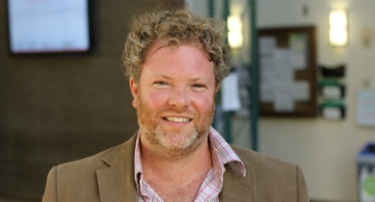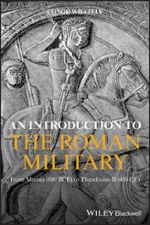Classics talk: "The soldier's life in Ancient Rome"
Thu. Dec. 3, 2020
The Classics Department continues its series New Directions in Classics virtually this year. On November 20, Dr. Conor Whately gave his talk The soldier’s life in Ancient Rome. The talk was also an unofficial launch for Dr. Whately’s new book, An Introduction to the Roman Military: From Marius (100 BCE) to Theodosius II (450 CE) (John Wiley and Sons 2020). Whately is Associate Professor and Acting Chair of the Classics Department.

Dr. Conor Whately's new book follows the lives of three Roman soldiers from the historical record.
Photo credit: Naniece Ibrahim

An Introduction to the Roman Military: From Marius (100 BCE) to Theodosius II (450 CE) (John Wiley and Sons 2020)
It’s a fourth book for Whately, but one that he started thinking about writing in 2010 when he first taught a course on the Roman army at UWinnipeg. At that time, he found that the existing textbooks on the subject were highly detailed and required a background in classical antiquity that some of his students didn’t have.
A military enthusiast himself, Whately new book is intended for those who are not. In fact, in the introduction, Whately declares, “If I had any advantage, it’s that I have several close friends and family, some colleagues, who have little or no interest in the Roman military. As I conceived of, prepared, and wrote this book I had them in mind. How should I write something that they might understand – even enjoy, especially on a topic that they had little interest in otherwise?” (p. xii-xiii).
When the time came to start the book, Whately had to consider how to approach the subject matter, either thematically or chronologically. He initially favoured taking a thematic approach. However, the limitation of this approach, he says, is that it doesn’t deal well with change as it evolves over time. In keeping with his goal to make the book “readable”, Whately liked that the chronological approach would allow him to present the information a story with a beginning, a middle and an end.
In what seems to me to be a brilliant idea, Whately decided to follow the lives of three particular Roman soldiers from the historical record, each of whom represents a different period in time. This enabled him to highlight the changes which took place over the period of time covered by the book. The book follows the military lives of these three from their enlistment to retirement (and beyond), but is otherwise organized thematically.
Of particular interest to Whately is military life in the frontiers. His own travels have taken him to parts of modern day northern England, Bulgaria, Germany, and Jordan, places which during antiquity were the frontiers of the Roman Empire. The soldiers he features are individuals who lived in these frontier areas: (i) Titus Pullo (Late Republic), (ii) Aurelius Polion (High Roman Empire), and (iii) Flavius Aurelianus (Late Antiquity).
It is an effective approach, according to Dr. Peter Miller, Department Chair (on leave) and co-host, with Classics alumna Ruth Dickinson, of the New Directions in Classics series. In introducing Whately, Dr. Miller states, “This an admirable way to structure the book. There is a sense of story that you’re drawn to reading.” Miller adds that the book offers “a great synthesis of social history as well as military history.”
Whately’s approach also lends itself to focusing on the human experience of the soldiers. This is something Whately sought to do with the book, and it is something that differentiates his book from previous treatments of the subject, he says. He notes that recent work being done in the field takes a greater interest in the lives of the “non-male members” of the military.
Whately incorporated as much diverse evidence as he could in order to broaden what we can learn about life at that time. Some of the examples he gave during his talk included:
- Letters to and from soldiers’ families which often reveal aspects of daily life.
- Zooarchaeological evidence, such as animal remains, reveals what people ate.
- Legal evidence reveals important information about family life, as it was against the law for soldiers to marry until the 4th
Judging by the response of the Zoom audience, there will lots of interest in the book. Most of the questions for Dr. Whately – and there were a lot of questions! – it seemed dealt with the various of aspects of the lives of soldiers and their families at that time, rather than their military service.
Peter Miller suggested, as he opened up the talk for questions, this would make a great item for your holiday list, or as a gift for someone else. I agree wholeheartedly that it would. And with a follow-up by Whately, A Sensory History of Ancient Warfare: Reconstructing the Physical Experience of War in the Classical World, in the works, and expected to be published in 2021, you’ll be set for next year too!
Forthcoming books
A Sensory History of Ancient Warfare: Reconstructing the Physical Experience of War in the Classical World (Pen & Sword, probably 2021)
Roman Soldiers, Military Institutions, and Procopius (Brill, probably 2021)
Previous books
Battles and Generals: Combat, Culture, and Didacticism in Procopius’ Wars (Brill 2016)
Exercitus Moesiae: The Roman Army in Moesia from Augustus to Severus Alexander (British Archaeological Reports Oxford Ltd 2016)
Greek and Roman Military Manuals: Genre and History (Routledge 2020), Co-edited with James T. Chlup
